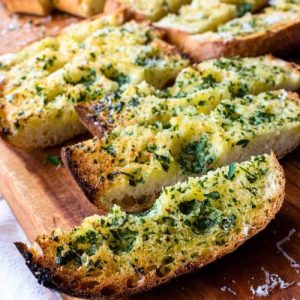Experience the perfect harmony of crispy crust and soft, fluffy interior with this irresistible Ciabatta Garlic Bread.
Infused with a rich garlic-parsley butter and a hint of Parmesan, it delivers bold flavor without overwhelming your palate.
This recipe is not only satisfying but also provides a modest boost of protein from the cheese and healthy fats from butter.
Quick, easy, and ideal for everyday cooking, it’s a versatile side that complements weeknight dinners, casual gatherings, or meal prep, bringing both comfort and convenience to your table.

Ciabatta Garlic Bread
Equipment
- 1 Large Baking Sheet
- 1 Small Mixing Bowl
- 1 serrated knife
- 1 palette knife or spatula
Ingredients
- 1 ciabatta loaf
- ½ cup salted butter softened
- 4 garlic cloves finely chopped
- 2 tablespoons finely grated Parmesan cheese plus extra for sprinkling
- 2 tablespoons finely chopped flat-leaf parsley
- ⅛ teaspoon fine salt
Instructions
- Preheat the Oven and Prepare Your Baking Sheet: Start by preheating your oven to 425ºF (220ºC). This high temperature ensures that your ciabatta develops a perfectly golden, crispy crust while keeping the inside soft and tender. At the same time, line a large baking sheet with parchment paper or lightly grease it with a small amount of butter or oil. This prevents sticking and makes cleanup much easier. Set the prepared baking sheet aside as you move on to the next step.
- Slice the Ciabatta Loaf: Using a serrated knife, carefully slice the ciabatta loaf in half lengthwise. Hold the loaf firmly with one hand on top while gently sawing back and forth with the knife. The serrated edge ensures a clean cut without squashing the soft interior. Place the two halves cut side up on your prepared baking sheet so that they are ready for the garlic butter.
- Prepare the Garlic Paste: Peel the garlic cloves and finely chop them. Sprinkle a pinch of salt over the chopped garlic—it helps to break down the fibers and releases a more intense flavor. Using the flat side of your knife, press and scrape the chopped garlic repeatedly until it transforms into a smooth, uniform paste. This step is crucial to avoid large chunks that can overpower a bite and ensures the garlic flavor is evenly distributed.
- Mix the Garlic Butter: In a small mixing bowl, combine the softened butter with the garlic paste, finely grated Parmesan cheese, and chopped flat-leaf parsley. Mix thoroughly using a spoon or spatula until all ingredients are evenly incorporated into a creamy, fragrant butter mixture. The Parmesan adds a savory, slightly nutty depth, while parsley brings a fresh, herbaceous note.
- Spread the Garlic Butter: Using a palette knife or small spatula, carefully spread a thin, even layer of the garlic butter mixture over the cut side of both ciabatta halves. Make sure to cover every corner so that each bite is flavorful. Take your time to ensure the butter is distributed evenly, but avoid overloading any area, as too much butter can make the bread soggy instead of perfectly soft inside with a crisp crust.
- Bake the Bread: Place the prepared ciabatta halves on the baking sheet in the preheated oven. Bake for 10–15 minutes, keeping a close eye on the bread. You want the butter to melt completely, the edges to turn golden brown, and the crust to become lightly crisp. Oven temperatures vary, so check the bread after 10 minutes to prevent over-browning.
- Add Extra Parmesan and Finish: Once baked, remove the bread from the oven and immediately sprinkle additional grated Parmesan over the top while it is still hot. The residual heat will melt the cheese slightly, creating a richer flavor and a visually appealing, golden finish.
- Slice and Serve: Allow the bread to cool just enough to handle safely, then cut into 2-inch (5 cm) slices using your serrated knife. Arrange the slices on a serving platter, ensuring that each piece showcases the soft interior and golden crust. Serve immediately while warm for the best flavor and texture.
- Optional Tips for Perfect Results: Always use softened, not melted, butter for the best consistency and spreadability.Wash and pat dry the parsley thoroughly before chopping to avoid any extra moisture.If your bread isn’t as golden as you’d like after 15 minutes, briefly switch to the broiler/grill function for 1–2 minutes—watching carefully to prevent burning.For an extra aromatic touch, rub a lightly toasted garlic clove over the warm bread before serving.
Notes
- Always use a serrated knife to slice ciabatta for clean cuts without squashing the soft interior.
- Use softened butter, not melted, for easier spreading and better texture.
- Mince garlic thoroughly to create a smooth, even paste—large pieces can overpower bites.
- Wash and dry parsley completely before chopping to prevent soggy bread.
- Oven temperatures vary; check bread after 10 minutes to avoid over-browning.
- Extra Parmesan sprinkled on top enhances flavor and visual appeal.
- Serve immediately for best taste, as garlic bread is most flavorful when warm.
Chef’s Secrets For Perfect Bread
To achieve the ultimate garlic bread, attention to detail makes all the difference.
First, slicing the ciabatta correctly is crucial—using a serrated knife ensures the crust stays intact while revealing the soft interior.
Softened butter, not melted, guarantees that the garlic-parmesan mixture spreads evenly without pooling.
Transforming the garlic into a fine paste releases maximum flavor without creating harsh bites.
Finally, keeping an eye on the oven allows the bread to reach a golden, crisp finish without overcooking.
Small steps like these elevate homemade garlic bread from ordinary to extraordinary.
Serving Suggestions For Every Meal
Ciabatta Garlic Bread is versatile and pairs beautifully with countless dishes.
Serve it alongside classic Italian pasta dishes like spaghetti Bolognese, fettuccine Alfredo, or creamy tomato soup for a comforting meal.
It also complements grilled vegetables, roasted chicken, or hearty stews, providing a crisp, buttery contrast.
For casual gatherings, cut into smaller slices and offer as an appetizer with dips like marinara, hummus, or spinach-artichoke dip.
Its golden, garlicky flavor makes it perfect for brunch, lunch, or a quick snack anytime.
Storage Tips To Keep Fresh
To maintain flavor and texture, store leftover garlic bread in an airtight container at room temperature for up to 2 days.
Avoid refrigeration, as it can make the bread dry and tough.
For longer storage, wrap tightly in foil and freeze for up to 1 month.
Reheat in a preheated oven at 350ºF (175ºC) for 5–7 minutes, or until warmed through and slightly crisp on the edges.
Avoid microwaving, as it can make the bread chewy and compromise the texture.
Frequently Asked Questions About Bread
1. Can I use a different type of bread?
Yes! While ciabatta works best for its airy texture and sturdy crust, you can use baguette or French bread as alternatives. Adjust baking time slightly depending on thickness.
2. Can I make this recipe ahead of time?
Absolutely! You can prepare the garlic butter mixture in advance and spread it on the bread just before baking. This helps save time without compromising flavor.
3. How can I make it extra crispy?
For an ultra-crispy crust, briefly broil the bread for 1–2 minutes after baking, watching carefully to prevent burning. The result is a golden, crunchy top with a soft interior.
4. Is there a way to reduce the saturated fat?
You can substitute half of the butter with olive oil to lower saturated fat while retaining rich flavor. Alternatively, use a light butter spread if preferred.
5. Can I add other flavors to the garlic bread?
Yes! Consider adding finely chopped rosemary, thyme, or a pinch of chili flakes for a flavorful twist. You can also experiment with different cheeses like mozzarella or Pecorino Romano for extra richness.
